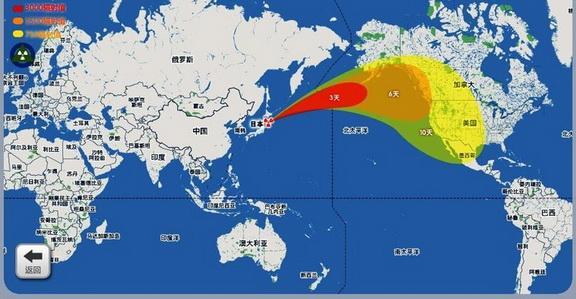福岛核辐射污水 每天300吨流入太平洋(图)
文章来源: 世界日报 于 – 新闻取自各大新闻媒体

日本官员七日表示,自二○一一年「三一一」地震海啸后,福岛第一核电厂每天流入太平洋的辐射污水估计约三百公吨。日本首相安倍晋三誓言,政府将更积极介入防堵辐射污水外泄。
经营福岛核电厂的东京电力公司上月才承认有辐射污染的地下水流入海里,处理核灾能力饱受批评。安倍七日参加原子能灾害对策本部会议后表示:「污水问题是日本民众高度关心、必须处理的紧要课题。政府不会依靠东电,将采取措施应对。」
安倍说:「为确保安全,我希望原子能规制委员会首长能尽力找出原因、拟定有效措施。」
安倍下令经济产业省紧急处理,确保东电采取适当行动清理善后,估计核灾清理需时四十多年,花费一百一十亿美元。但安倍未承诺将动用多少预算。不过,经济产业省已要政府拨款。日本经济新闻说,这笔资金将用于冻结土壤,以防止地下水流入反应炉建物下方。估计这项方案需花费四百亿日圆(约台币一百廿亿元)。
经济产业省官员说,东电将开始抽地下水,目标在十二月之前每天抽出三百公吨地下水,但届时可能距预定目标还差六十公吨。抽出三百公吨地下水,不代表能完全阻止污水流入海里。
东电把从山区流到核电厂下方的地下水抽出,这些地下水混合了用于冷却三座反应炉内熔化的燃料的高辐射污染水。东电试图以「绕道」方式,建立一条旁道,防止地下水流到反应炉下方。
东电和经济产业省自五月起展开另一项防堵措施,试图把土壤冻结,以防止地下水流入反应炉建物。类似技术用于避免地下水进入地下铁系统。日本官员说,东电的冻土计划规模之大「举世无双」。
这项计划是将四座毁损反应炉方圆一点四公里的土地冻结,方法是把冷媒灌到地下,建立冻土墙,防止地下水流入电厂。但专家说,维持土壤温度几个月就耗费巨资,遑论数年。(David)
日本东电首次承认海水遭核污染
文章来源: 中国之声 于 – 新闻取自各大新闻媒体,新闻内容并不代表本网立场!
 原标题 [日本东电首次承认海水遭核污染 桃子变异像葫芦]
原标题 [日本东电首次承认海水遭核污染 桃子变异像葫芦]
据中国之声《新闻纵横》报道,最近,韩国一家网站发布了一批产自日本的蔬果和花卉照片。照片中水果、蔬菜和花卉要么形状发生畸变,要么多个果实聚成一团,要么巨大,例如一个桃子变成“8”字形状,看起来像个葫芦。按照媒体的说法,核泄漏的影响似乎已经进入食物链,导致出现变异蔬菜。
对于核泄漏进入食物链的指责,日本东京电力公司一直不愿意承认,甚至否认海水受到了污染。不过,前天日本东京电力公司改口了,承认受福岛核电站事故影响的放射性地下水已经泄漏到港湾海水里,这加重了民众对海洋污染的担忧。
尽管东日本大地震已经过去了两年,但方圆十公里内渺无人烟的福岛核电站,依然是埋在太平洋沿岸一枚危险的炸弹。东京电力公司本月22日首次向外界透露,确认发现被污染的地下水正向海中渗漏。
东京电力公司新闻发言人小野正幸:我们从核电站车轮机房的地下检测出了很高的辐射值,此事给大家造成的担心和忧虑,尤其是对福岛民众,我们深表歉意。
上个月19日,东京电力公司就曾表示,该公司从福岛第一核电站2号机组涡轮机厂房靠海一侧的观测井的地下水样本中,检测出了高浓度的放射性“锶90”和“氚”。
检测结果当中显示,其中放射性锶浓度大约为每公升1000贝克勒尔,超过法定标准的30倍。据了解,放射性锶是核燃料“铀”的裂变产物,和“钙”有着近似的性质,容易进入人体的骨头里,有可能引起骨髓癌、造血机能障碍等等的疾病,并且“锶90”的半衰期长达近30年。
不过之后,东京电力一直断然否认有任何污染水泄漏到了海洋中,尽管多项独立研究显示,附近海域的辐射水平表明情况与他们所说的不同。东京海洋大学海洋学家神田穰太早前发表了一份研究,分析了东京电力自己公布的核电站附近海域的辐射水平读数。该研究得出结论称,这极有可能是因为核电站正在泄漏。本月10日,日本原子能管制委员会主席田中俊一也曾表示,“海水中的放射性水平一直很高,而且污染还在继续,任何人也否认不了这一点,我们必须尽快采取行动。”不过当天东京电力公司称,公司不能确定有没有污水进入海洋。
迫于压力,前天东电公司才正式承认海水受到污染。公司发言人称,由于在出现潮位变化和降雨时,福岛第一核电站院内靠海的水井内的水位也随之变化,所以判断核电站院内与海之间存在水的流动,证明有污水流入了海中。但同时东电的新闻发言人小野正幸表示,辐射水对海洋的影响有限。
小野正幸:海水数据显示,海洋中的放射水平没有异常增高。根据水样本监测,泄漏的污染水依然留在核电站附近海湾内。
针对东电公司首次承认福岛核电站污染水流入海湾,日本内阁官房长官菅义伟也立刻出面做出表态,称日本政府将尽力应对。
菅义伟:我们得知福岛核电站很可能有污水渗透入大海,日本政府目前正在就此事认真商讨。经济产业省已经奉命采取措施,对泄漏入海的污水进行阻隔。
检测出高浓度放射性污水的消息也令福岛县的渔业相关人士十分的苦恼,福岛县相马市的一名从事渔业工作的男性说,无论东电公司怎么解释,问题就发生在海边上,这肯定又会给当地渔业造成打击,污水问题已经令他们感到十分厌烦。
目前,东电公司并没有公布海水受污染的就具体数据,但在福岛周围捕鱼已经停止。当地政府禁止在周围地区生产牛肉、牛奶、蘑菇和蔬菜。
日本福島核或洩至太平洋
TOKYO (AFP) – Japan’s nuclear watchdog said Wednesday the crippled Fukushima reactors are very likely leaking highly radioactive substances into the Pacific Ocean.
Members of the Nuclear Regulation Authority voiced frustration at Tokyo Electric Power (TEPCO), which has failed to identify the source and the cause of spiking readings of radioactive materials in groundwater.
“It is strongly suspected that highly concentrated contaminated waste water has leaked to the ground and has spread to the sea,” the authority said in its written review of TEPCO’s recent announcements.
The giant utility that services Tokyo and its surrounding regions has said groundwater samples taken at the battered Fukushima Daiichi plant on Tuesday showed levels of possibly cancer-causing caesium-134 were more than 110 times higher than they were on Friday.
TEPCO has failed to identify the exact reasons for the increased readings but has maintained that the toxic groundwater was likely contained at the current location, largely by concrete foundations and steel sheets.
The company has admitted in recent weeks that water and soil samples taken at the Fukushima plant are showing high readings for other potentially dangerous substances, including caesium-137, tritium and strontium-90.
“I see (TEPCO) has not been able to find the cause of these spikes in readings,” NRA Chairman Shunichi Tanaka told a meeting of its commissioners.
“TEPCO says there has not been meaningful impact on the environment. But we must see for sure what are the possibilities of this leading to oceanic contamination,” said Toyoshi Fuketa, an NRA commissioner.
NRA officials are urging TEPCO to offer more detailed and credible data and make efforts to better explain to the public what it knows.
The substances were released by the meltdowns of reactors at the plant in the aftermath of the huge tsunami of March 2011, which swamped cooling systems at the plant.
Tens of thousands of people were forced from their homes by the threat of radiation in the planet’s worst nuclear accident for a generation.
TEPCO is struggling to manage the clean-up at Fukushima, which scientists say could take up to four decades to complete.
Thousands of tonnes of water used to cool reactors is being stored on site, and technical set-backs — including storage tank leaks and power outages — occur frequently.
Critics of the utility say it adopts a head-in-the-sand approach to problems at the plant, where ad-hoc fixes have left equipment vulnerable to quakes and tsunami in tectonically volatile Japan.
Although the radiation leaks from the Fukushima accident are not officially recorded as having directly killed anyone, the earthquake and tsunami that caused them claimed more than 18,000 lives and was one of Japan’s worst ever peacetime tragedies.

